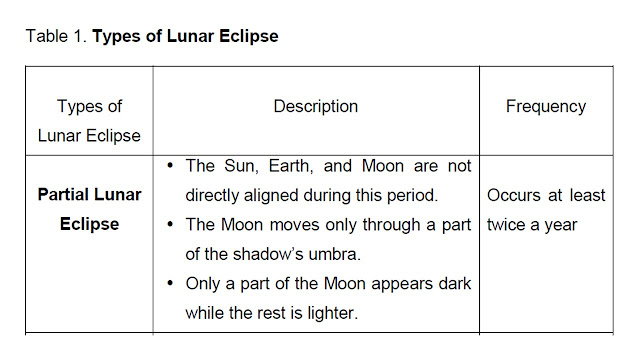Solar and Lunar Eclipse
Eclipse
Simple video animation (watch the short video to answer the following Guide Questions):
Guide Questions:
1. What are the 2 kinds of eclipses?
2. Describe the difference between umbra and penumbra.
According to the National Aeronautics and Space Administration, or NASA, "An eclipse happens when a planet or a moon gets in the way of the Sun’s light."
Two distinct parts of the Earth’s shadow during a solar eclipse:
1. Umbra – refers to the darkest part of the moon’s shadow formed on the Earth where a total solar eclipse is seen
2. Penumbra – refers to the lighter part of the moon’s shadow formed on the Earth where a partial solar eclipse is visible
Two distinct parts of the shadow created during a lunar eclipse:
1. Umbra – the darker inner region of the Earth’s shadow where all the sunlight is blocked out
2. Penumbra – the lighter outer region of the Earth’s shadow where the sunlight is partially covered
Why Does NASA Study Eclipses?
Hundreds of years ago, when people observed the Moon during an eclipse, they saw Earth's shadow on the Moon and discovered that the Earth is round. Even after all these years, scientists are still learning about the Moon from lunar eclipses. In December 2011, NASA’s Lunar Reconnaissance Orbiter gathered data about how quickly the Moon's day side (the side that always faces Earth) cools during a lunar eclipse. NASA can learn what the Moon's surface is made of from this data. If an area of the Moon's surface is flat, it will cool quickly. Scientists use this data to know which areas of the Moon are rough with boulders and which are flat.
Scientists use solar eclipses as an opportunity to study the Sun's corona. The corona is the Sun's top layer. During an annular eclipse, NASA uses ground and space instruments to view the corona when the Moon blocks the Sun's glare.
Remember, never look directly at the Sun: Doing so can permanently damage your eyes!
Credits:
- Science7_Q4_M6A_v2.pdf
- Science7_Q4_M6B_v2.pdf
- www.canva.com
- https://spaceplace.nasa.gov/eclipses/en/
- https://www.nasa.gov/audience/forstudents/5-8/features/nasa-knows/what-is-an-eclipse-58
- https://cdn.britannica.com/s:800x1000/30/91230-050-EBCE78FB/eclipse-Moon-sun-Earth.jpg
Please Subscribe for more educational videos - E-learning Virtual Assistant
**LET'S CONNECT**
Facebook Page: E-learning Virtual Assistant
Instagram: @your.elearningva
HeyLink: E-learning Virtual Assistant
THANK YOU SO MUCH! 😍












Comments
Post a Comment